Southborough
Southborough…I dunno, it’s Southborough. Not much to say here.
 |
| The platform. |
Southborough’s platform is a long low-level affair, with bike racks and shelters on both sides (featuring a bit of historical information) and benches and wastebaskets spread around. There are typical 90s-00s mini-high platforms at the western end of the station that offer a few more benches. The outbound platform has this weird abandoned field alongside it – there’s an exit that leads through it out to Southville Road.
 |
| Going down the ramp. |
A Fairmount Line-style ramp (with a staircase alternative) leads down to River Street from the outbound platform, complete with a bench in the middle of it. The inbound side is only a staircase, while the accessible ramp route is via the parking lot. As for parking, Southborough contains 364 spaces.
 |
| A train leaving the station. |
Station: Southborough
Ridership: This is the busiest of the infill stations added between Framingham and Worcester in 2000-2002, as well as the fifth-busiest station on the whole Worcester Line – it gets 1,051 inbound passengers per weekday.
Pros: The station is accessible and it has your basic Commuter Rail necessities. Cool.
Cons: Hmmm, there’s an abandoned field with no current purpose right next to this station whose parking lot fills up very early in the morning. It’s in a very undeveloped area that probably won’t see any big new buildings. How about building some more parking? Also, the mini-high platforms are the furthest they could possibly be from the station entrance, and since the ramps are the only way to cross the tracks, passengers could have to walk over half a mile to get to their cars coming home in the evening!
Nearby and Noteworthy: “Fitzgerald’s General Store.” That’s about it.
Final Verdict: 4/10
The station itself is okay, but I can’t get over some of its glaring problems. The walk from the outbound mini-high to the parking lot is borderline ridiculous, and I wish I could’ve properly timed it out when I was there. Also, the fact that the lot fills up really quickly shows the need for more spaces, which could be easily added in that field. Seriously, what the heck else is it doing just sitting there?
Latest MBTA News: Service Updates
Happy Thanksgiving! I have officially started the Downtown Crossing review. NO idea when it’ll be complete, but I’ve started it!
West Natick
The Worcester Line is interesting because past Boston Landing, it’s basically half accessible and half non-accessible stations. What’s more, the line is split halfway between them, with all of the non-accessible stations in a clump; ditto for accessible ones. West Natick is supposed to be the first stop of the latter bunch, but unfortunately, that wasn’t the case when I visited it.
 |
| That’s not accessible! Also, hi, artsy train! |
When Sam and I were here, the mini-high platforms were still being worked on. They had had some sort of structural issue that made them really dangerous, so they had to be repaired. Luckily, since then, they have been reopened, so everything at West Natick is accessible again!
 |
| The rest of the platform. |
Other than that, West Natick’s platform is standard stuff. The outbound side is nothing more than some signs, benches, and wastebaskets, while the inbound side gets a nice wooden shelter. One interesting aspect of the shelter is the marsh-type grass behind it, which gives it more of a unique flavor. To cross between the tracks, you have to use these annoyingly unstable wooden boards.
 |
| What is this, the artsy photos post? I don’t even know how this came out this way, but it looks cool! |
There’s a small plaza behind the shelter with a few old honor boxes, a single tree, and an old payphone. The station parking lot is tiny, with only 178 spaces – Dave’s Framingham/Worcester Line blog says it reaches capacity by 6:30 AM. West Natick has a good amount of bike parking, though, in the form of three completely different bike racks all lined up next to each other.
 |
| Yet another artsy train picture. |
Station: West Natick
Ridership: Believe it or not, this is the third-busiest station on the Worcester Line, getting 1,121 inbound riders per weekday. You wouldn’t think that from looking at it, would you?
Pros: I’m really impressed that this station gets so much ridership, considering that its parking lot is so small. Where the heck do those extra 900-or-so people come from? I mean, I doubt they’re coming from the MWRTA 10, which serves the station! Also, it’s good that it’s accessible again, thanks to the rebuilt mini-high platforms.
Cons: The whole station feels kinda ramshackle, what with its barebones platforms, the random bike racks, and those wooden boards used to cross tracks. Also, I know there’s no room for any more spaces, but man, that’s a small parking lot!
Nearby and Noteworthy: There’s a small shopping plaza next to the station with a few businesses, but that’s really about it.
Final Verdict: 5/10
For such a busy stop, I expect a little more than this. I mean, West Natick is passable, but it has a lot of issues. At least they fixed up that mini-high platform, though – otherwise, I would have to make the score even lower.
Latest MBTA News: Service Updates
SRTA: NB 1 (Fort Rodman)
During my brief stay in New Bedford, how could I not resist riding at least one SRTA route? I only had about an hour until my bus back to Boston was departing, so I had to do something quick. The 1 caught my eye: it runs every 20 minutes to a peninsula in southern New Bedford. Sounds great, let’s do it!
 |
| Taking good pictures in the SRTA terminal is hard! |
After I tapped my CharlieCard (why does the SRTA, a system that doesn’t even connect to the Commuter Rail, use it while systems like the GATRA and RIPTA don’t?), we headed down 6th Street. There were dense buildings everywhere, and they continued as we turned onto Spring Street. Next, we went down Acushnet Ave, where the taller buildings from before became 2-3 story affairs.
 |
| A pretty desolate side street. |
We went alongside a monolithic apartment development for a while before turning onto Grinnell Street, which was lined with triple-decker apartments. They continued as we turned onto County Street, which also had a few businesses and churches along it. At one point there was a retail-heavy section where almost every building had a business on its ground floor.
 |
| This picture is basically the 1 in a nutshell. |
We eventually made turns onto Cove Street, then Rodney French Boulevard, and both of them kept up the businesses in three-story apartment buildings pattern. Next, we swung onto Brock Ave for a block, then Ruth Street, which was entirely residential for a bit. This was a jog to serve a big apartment building, and once we headed past it, we turned onto East Rodney French Boulevard.
 |
| Making a turn. |
We were right by the water, but it was sadly blocked by a big wall. There was some brief industrial scenery as we turned onto David Street, but it went back to those familiar triple-deckers soon enough. We came back onto Brock Ave, passing more apartments and businesses, as well as a high school.
 |
| I can see the water way down there! |
One side of the street was occupied by a park for a bit, and as we continued south, some of the apartments became normal houses. We passed through another park, complete with a pond, and it was all low suburban houses after that. At the end of Brock Ave, the bus just made a u-turn and we headed right back up the way we came.
 |
| No triple-deckers? Where are we?! |
SRTA Route: NB 1 (Fort Rodman)
Ridership: I can’t find any SRTA ridership statistics, but I can say that when I rode this route, it was hoppin’ – there were about 20 people who rode in each direction! Let me tell you, after a day on the GATRA, it was amazing to see this many people on a bus.
Pros: This is a nice short route with a lot of local ridership. It’s also pretty darn frequent: weekday service is every 20 minutes, while Saturday service is every 40 minutes. I also like how only the outbound route makes the jog to serve that apartment building, since it speeds the bus up heading back the other way.
Cons: The SRTA seems like a busy enough system to be able to implement some form of Sunday service. I could totally see people using that on a route like this.
Nearby and Noteworthy: Triple-deckers, triple-deckers, and triple-deckers. Oh, also triple-deckers.
Final Verdict: 8/10
The 1 is a really solid route on a really solid network. I didn’t get to experience much of the SRTA, but from my ride on this bus, it seems like a great system. Maybe someday I’ll be able to come back and see some of its other routes…
Latest MBTA News: Service Updates
GATRA: Wareham – New Bedford Connection
What the heck is this route and where did it come from? The Wareham – New Bedford Connection sprung up on the GATRA website with this announcement page, featuring two maps saying exactly the same thing, some points of interest at each terminus of the route, and the awkward sentence, “Starting February 6, 2017, GATRA and SRTA are starting a new bus service between Wareham and New Bedford.” This is all a lot of hype for a route that only runs Monday, Tuesday, and Wednesday, isn’t it??
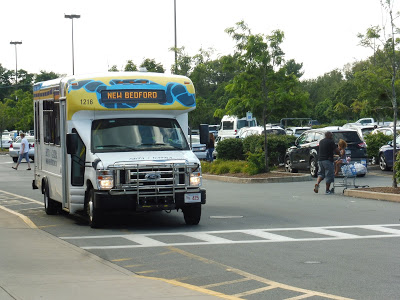 |
| It gets its own bus, too?! |
What exactly is the route? Well, this is a partnership between the GATRA and the SRTA to bridge the gap between the two systems and provide an important connection between Wareham and New Bedford. Okay, first of all, the SRTA is one of the better RTAs in Massachusetts (I’ll talk about my ride on one of their routes later on) while the GATRA is one of the worst, so…that’s an interesting partnership. Also, may I remind you that the route only runs Monday, Tuesday, and Wednesday???
 |
| Cutting-edge farebox technology right here. |
I couldn’t see any fareboxes when I got on, so I assumed people just gave it to the driver. When I tried to do that, he pointed behind him at a rusty metal box. Oh my God, that is literally the farebox, isn’t it? Aside from that, the minibus was fine, but I got a good laugh out of the insanely primitive farebox.
 |
| A single train track. |
We headed down Cranberry Highway and turned onto Depot Street. This was residential for the most part, but there were some industrial buildings when we crossed a train track, then turned onto Minot Ave, joining the 1. It was mostly woods, aside from the occasional housing development.
 |
| Lovely! |
The street became Narrows Road, which was mostly marshy aside from a shipyard. Next, we crossed over the Wareham River and merged onto Main Street, going through Wareham Village. There were a lot of charming buildings that could theoretically house retail, but a lot of them were either vacant or boring.
 |
| Some side street. |
After leaving the village, we turned onto Chapel Street, passing the Wareham Library, Middle School, and Town Hall. There was a mix of houses and retail from there, including a Shaw’s that we had to deviate into. The road turned into Marion Road, and the scenery got pretty darn woodsy for the most part.
 |
| Wow! |
That didn’t last too long, though, as we soon crossed over the Weweantic River, giving us an absolutely fantastic view. This took us into Marion, where there were more trees and houses and the street became Wareham Road. We also got the occasional retail break, such as a shopping plaza and a fish market.
 |
| Some boats! |
After going by a cove, more businesses started to show up along the road. Soon after that, we arrived at a cluster of retail, but it was basically just a few gas stations and suburban businesses. We went by a private boarding school and the Marion Police Department as we curved south on Mill Street, then it was more woods. The route unfortunately bypasses Marion Center, which looks incredibly charming – it’s about a ten minute walk from the route.
 |
| A historic-looking cemetery. |
After a few industrial buildings and a cemetery, the road became entirely sparse houses and forest, eventually turning into only the latter. Suddenly, out of nowhere, a huge school came up…and then it was woods again. However, as we entered Mattapoisett, some residential and retail buildings started to appear once more.
 |
| Some houses. |
For the next while, it was mostly just houses and suburban businesses along what was now called County Road. There was one point where the retail with parking lots got just a little bit denser, and I think that might have been “downtown Mattapoisett,” in which case…gross! It became Fairhaven Road after that mess, and it continued to be that mix of houses and businesses.
 |
| Part of “downtown Mattapoisett”…ew! |
We went over the narrow Mattapoisett River, and after more of the same scenery, the road became Huttleston Ave and we entered Fairhaven. This leaned a little more on the residential side of things, but it was still that mix that we had been seeing for most of the route (albeit a little denser). All of a sudden, the road got really wide and a slew of shopping malls came out of nowhere.
 |
| Aw man… |
We turned onto Route 240 at this point, which was basically a highway. Next, we turned onto Bridge Street, then Mill Road, in order to serve the Southcoast Health System, two hospitals. We returned to Route 240 and continued north. It soon led us to an interchange with I-195, onto which we headed west for an express section!
 |
| Serving the hospital. |
The scenery was basically forest all the way until we crossed the Acushnet River into New Bedford. Once there, we took Exit 15 onto Route 18, another highway that went by a lot of industrial buildings. We eventually took an exit onto Purchase Street, which curved its way past a variety of dense buildings with different uses. Things started to get denser, but before we entered the heart of downtown New Bedford, we turned into the SRTA Terminal, finishing quite a long and diverse trip.
 |
| A minibus with a full-sized bus behind it…this just doesn’t look right! |
 |
| The back of the bus |
GATRA Route: Wareham – New Bedford Connection
Ridership: This is a very new route, so there aren’t any public ridership statistics yet. My ride had two other people – one of them was a very kind woman who talked to me for much of the trip, and made the journey unique and enjoyable. Two people is of course terrible ridership, but we’ll see why it’s that low soon.
Pros: This route has so much potential! It serves some decently populated towns right along their main drags and connects up important sections of the region, as well as two bus systems. Seriously, this route could be great.
Cons: The GATRA and the SRTA worked for four years to make this route happen. You would think that would mean they wouldn’t, I dunno, set it up to fail? Honestly, those 2 people seem like a lot more when you see that the route runs Mondays, Tuesdays, and Wednesdays only, with trips at 7:30, 9:30, 2:00, and 4:00. Yeah, you know what, if two whole people are willing to ride this thing with that schedule, that’s a heck of a lot of riders!
Nearby and Noteworthy: This is technically the only way to get to New Bedford by local transportation (Commuter Rail to Lakeville Connector to this)! Also, Marion Center looks really charming if you’re willing to make the short walk.
Final Verdict: 2/10
If this route ran, say, every hour throughout the week, I could see it getting a 6 or a 7…as well as a lot more riders. I seriously think that if two people are willing to use this (and obviously more people on other trips) in its current state, it could be a really successful route if it had an actual schedule! As it is, though, this route is absolutely useless. Just look at this article try to come up with ways you can use this thing! For example, when talking about making connections from GATRA routes in Wareham, it says “the buses run just a tad earlier than the Connection, arriving at Cranberry Plaza well before it arrives. However there are several fast food restaurants in the area to get a cup of coffee while you wait.” If that’s not reaching to make the route sound good, I don’t know what is.
UPDATE: 5/10
Thank goodness, it finally happened – this route now runs five days a week! It still has the same schedule every day, but this is a vast improvement over how it ran before.
Latest MBTA News: Service Updates
GATRA: Link 2 (Cranberry Plaza to Buzzards Bay)
Wareham is considered by some to be part of the Cape. I personally would disagree – to me, you’re only on the Cape if you go over the canal. Well…today we’re actually visiting the Cape, because the 2 heads into Bourne, canal and all!
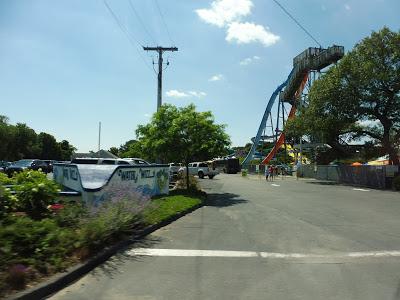 |
| I didn’t have time to get an exterior shot of the bus, so here’s a water park! |
We went onto Cranberry Highway from Cranberry Plaza, going by a mess of random places, including the water park seen above. Once we turned onto Main Ave, though, it became entirely residential, and they were dense houses at that. They continued even after we went over Broad Cove and merged onto Union Ave.
 |
| This review totally isn’t three months late…just ignore the people enjoying the summer beach. |
We reached the lovely Onset Village, but instead of going further into it like the 1, we went the other way, turning eastward onto Onset Ave. This took us right alongside Onset Beach, and the view was really nice. We went over the East River, and there was one last stretch of dense houses on the other side.
 |
| Why not, here’s another amazing view! |
The houses got further apart soon, though. We went by a golf course, and later on, we came very close to yet another body of water, Butler Cove. Next, Onset Ave went over some train tracks, the scenery got industrial, and we turned onto Cranberry Highway again. That became Main Street once we went over the Cohasset Narrows and entered Bourne.
 |
| This route is so scenic! |
 |
| That glorious railroad bridge really contrasts with the crap in the foreground… |
 |
| WE ARE LITERALLY GOING OVER THE BOURNE BRIDGE IN A MINIBUS!!!!!! |
 |
| This isn’t the Park and Ride! |
 |
| Well, there’s parking, but we’re still not in the right place… |
 |
| Finally! |
 |
| Another view from the other side of the Bourne Bridge! |
Pros: The more I think about this route, the more I realize there isn’t all that much that’s good about it. Well, it goes over the Bourne Bridge, and that’s absolutely amazing. Also, some of the trips time with Peter Pan buses in Bourne, which is nice. The route runs every hour on weekdays and every two hours on Saturdays, which matches the ridership all right. But…that’s really about it.
Cons: There are a multitude of problems I could talk about, such as the strange one-way routing to Onset Village, the inevitable traffic problems when crossing the Bourne Bridge, the weird padding (we left Buzzards Bay 6 minutes early going outbound), the confusing call-in flex service the route has in Bourne, or the fact that that whole loop we did before the park-and-ride was completely absent from the schedule. I think the biggest drawback for this route, though, is that it doesn’t need to run – it’s completely paralleled by the CCRTA Bourne Run route. Sure, that only runs every 90 minutes on weekdays only, but it travels much further (down to Mashpee) and it’s more direct to Bourne.
Nearby and Noteworthy: The Bourne Bridge! That view is so incredible!
Final Verdict: 3/10
This route is used by at least a few people, but I don’t know if it’s enough to justify keeping the service around, especially since the whole thing runs with the CCRTA. The CCRTA admittedly doesn’t run Saturday service on its Bourne route, but I still think the GATRA and the CCRTA should come up with some sort of agreement regarding this corridor – it seems to me that it would be much more efficient to just run the CCRTA along here.
Latest MBTA News: Service Updates
GATRA: Link 3 (Shangri-La to Cranberry Plaza)
Cool, a complete stinker that’s also really short. Let’s get the 3 out of the way.
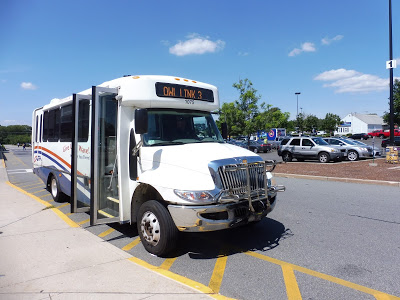 |
| NOT THIS STUPID TRUCK MINIBUS AGAIN! |
We headed out from Cranberry Plaza onto Cranberry Highway, which split into two one-way sections. Along this bit, we turned onto Glen Charlie Road, going along Union Pond and over Route 25. There were somewhat dense houses for about a minute, then it was just woods. Occasionally there would be sparse residences, but it wasn’t much. Eventually, we pulled into a 7-Eleven (although the schedule still calls it Tedeschi’s), and that was it.
 |
| Woods, woods, woods. |
GATRA Route: Link 3 (Shangri-La to Cranberry Plaza)
Ridership: For the first time…I don’t trust the numbers. Look, I just don’t see how this tiny route can get 26 people per day. That would mean over 6 people per round trip! But since my round trip garnered a total of one other person, the other trips would need to have over 8 people to meet that 26 number…and that just doesn’t seem possible! The driver even told me that only two people use the route every day, so something tells me GATRA made some sort of mistake when counting its ridership.
Pros: As far as I can see, absolutely nothing.
Cons: This route serves practically nothing. A few houses here and there, but nothing substantial enough to justify a bus service. There’s actually a sizeable residential neighborhood north of the route’s terminus, but since this has to get back in time to do the 4, it can’t go further. Anyway, even if the route did have a good ridership base, who would want to use it? It only has four hourly trips, weekdays-only – a very limiting schedule.
Nearby and Noteworthy: 7-Eleven, and that’s literally it.
Final Verdict: 1/10
I don’t trust those ridership numbers at all. Usually I’m a stickler for data, but my real-life experience with the 3 doesn’t match up with GATRA’s statistics, not even close. I could totally see GATRA making a mistake with their numbers, anyway. Yeah, this is a prime route to get rid of, because from what I can tell, it’s useless.
Latest MBTA News: Service Updates
GATRA: Link 4 (Cranberry Plaza to West Wareham)
Argh, I’m getting deja vu! The truck minibus…the double-deviation…this is literally the same thing as the Wareham Middleborough/Lakeville MBTA Connector. The only difference is that the Link 4 only goes about halfway.
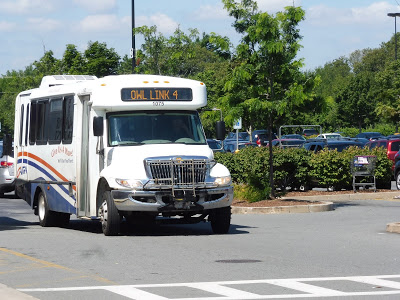 |
| YOU AGAIN! |
We left Cranberry Plaza on Cranberry Highway, which briefly split into two one-way sections before coming together again. It was industrial for the most part, with only the occasional residential neighborhood or cranberry bog popping up. And then, out of nowhere, we made a slight deviation from the MBTA Connector in the form of…a deviation. To the YMCA. Uh-huh, cool, good to see that my ride had exactly 0 people using the GATRA to get to the gym. What kind of stupid deviation is this??
 |
| Why?! |
We returned to Cranberry Highway and went over the Wareham River. After passing the sketchy-looking but apparently very good Mill Pond Diner, it went back to being mostly industrial. However, some businesses eventually showed up, and once we went over I-195, it was time for that double-deviation to the Wareham Crossing shopping center, then Walmart. Well…according to the schedule, at least. We just skipped right by!
 |
| Woods. |
Instead, we just continued down Cranberry Highway, going by more industry, houses, bogs, houses, woods, and industry, in that order. Once we got to County Road, which had a few businesses and Wareham District Court, we just pulled into a 7-Eleven gas station and turned around. That was it. Also, on the way back, we did do that double-deviation.
 |
| Yay… |
GATRA Route: Link 4 (Cranberry Plaza to West Wareham)
Ridership: The ridership for this route initially seems low: it gets 53 passengers per weekday and 29 per Saturday. However, because of the number of trips this route has, it ends up averaging out to about ten people per round trip. That’s not terrible for GATRA standards.
Pros: I find it interesting that this route gets a good amount of ridership, since from what I can see, it doesn’t really serve all that much. However, I guess a good amount of people does use this, so that’s a good thing! The route’s core schedule is sensible for the amount of riders it gets, with trips every hour on weekdays and every two hours on Saturdays.
Cons: First of all, that YMCA deviation felt really pointless. Maybe people on other trips take the bus there, but it seems a little fishy to me. Secondly, I don’t know why my trip skipped the double-deviation going outbound, but I really like that. Technically the route isn’t supposed to do it, but I like it a lot more. And actually, I have a sneaking suspicion as to why we skipped that deviation: this route seems to get late really easily. It gets absolutely no layover time at the terminus, and if it’s actually expected to perform all the deviations, it’s near-impossible to be on time. Also, it’s really annoying that the schedule for the 4 includes some (not even all) of the MBTA Connector trips – all it does is make everything more confusing. Keep them as separate routes.
Nearby and Noteworthy: Geez, I guess Wareham Crossing has some generic mall retail? There really isn’t much along the 4.
Final Verdict: 4/10
The 4 gets a 4! This is a route that’s clearly useful to a decent amount of people, but it has so many easily-fixable problems that drag it down. For example, does the YMCA really need to be served? Granted, I don’t have ridership data, so maybe scores of people use this route to get there, but I find that hard to believe. Secondly, the route is a recipe for lateness, and eliminating the double-deviation in one direction would help rectify that. It’s not that big of an inconvenience for passengers, although I personally don’t see much point in running the route beyond the Walmart anyway – there’s not much there. Finally, the schedule can be simplified by eliminating the MBTA Connector trips and moving them back to the timetable where they belong.
Latest MBTA News: Service Updates
GATRA: Link 1 (Wareham/Onset/Wareham)
Is this…a useful GATRA route? That people…use? What?? Wow!!! Apparently the Link 1 is a halfway-decent bus!
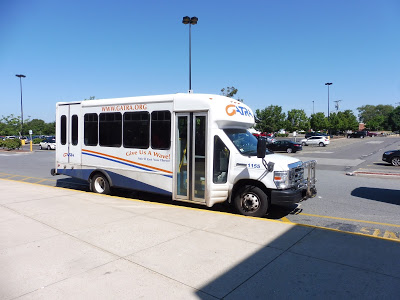 |
| Okay, the vehicle itself is terrible, but the route is good! This is at Cranberry Plaza. |
I’m starting this review at the southern terminus of this route, which is a loop around a suburban neighborhood called “Cromeset” (although everyone other than GATRA seems to call it “Cromesett” with an extra T). We made the little loop, then we went up Cromesett Road, which continued to be residential. We also had to do a weird little deviation to serve what I think is some sort of housing building (Google Maps doesn’t label it and my picture isn’t very good).
 |
| I dunno what this place is! |
There were a few businesses as we merged onto Marion Road, but it still remained mostly residential. Interestingly, Marion Road was also Route 6, the same Route 6 that continues onto the Cape to become its main thoroughfare. Anyway, we soon turned onto Swifts Beach Road, making what could be considered a “deviation,” but it was a busy one.
 |
| Deviating to a residential neighborhood that’s not a housing development? Woah! |
We went by some relatively spread-out houses at first, but there were also some developments along the way. As we got closer to the namesake of Swifts Beach Road, everything got denser, and soon there were lots of houses all squashed together. We did a little loop via some very narrow streets to turn around, and although it was sad that we didn’t get to go all the way down to the beach itself, this deviation netted us three paying passengers and two kids!
 |
| Grant Street was one of those tiny loop streets. |
Thus, we made our way back up Swifts Beach Road and came onto Marion Road again. We did a brief deviation to serve a small Shaw’s (the kind of deviation so short that you wonder why people can’t just walk across the parking lot from the street, but oh well – it’s GATRA we’re talking about), then we went by the Wareham Town Hall and Middle School. There were a few more houses as we turned onto Main Street, but things were about to change.
 |
| An interesting view coming out of Shaw’s. |
Soon we came into Wareham Village, offering a slew of businesses along Main Street. Unfortunately, most of the retail buildings were either boring or flat-out unoccupied, but, uh..it had potential? There was even a “Commuter Rail station” in the form of the CapeFlyer stop here!
 |
| Going over the Wareham River. |
We crossed over the Wareham River, where most trips would merge onto Minot Ave. However, I made sure to do one of the rare Link 1 trips that also serves Agawam Village, so we actually stayed on Sandwich Road for a bit. The Agawam Village deviation was well-executed, since the housing development was used as a path to make our way back to Minot Ave. It’s weird that it only happens three times per day, though.
 |
| We used Indian Neck Road to return to Minot. |
Now safely on Minot Ave again, we sped past sandy woods, suburban houses, and the occasional residential development (one of which, Brandy Hill Apartments, we deviated to). There were a few random retail and industrial buildings where we merged onto Onset Ave, which became lined with houses. They got denser and denser as we got closer and closer to Onset Village, until…
 |
| Here we are! |
All of a sudden, there were lots of charming businesses housed in really nice-looking buildings on both sides of the street. It wasn’t perfect – there were a few vacant lots and uninteresting businesses here and there – but it felt much more lively than Wareham Village. Plus, after we turned onto Union Ave and went through a brief residential neighborhood, there was a lovely section right along Broad Cove as we left the village!
 |
| I love the lone boat in the water! |
There were dense houses for a little while, but once we crossed a single train track and turned onto Cranberry Highway, it all fell apart. It was just a mess of completely random buildings, including a go-cart center, a trailer park, and a water park. After that mess, which was thankfully brief, we turned into Cranberry Plaza, the hub of the Wareham routes.
 |
| See ya! |
GATRA Route: Link 1 (Wareham/Onset/Wareham)
Ridership: This is, believe it or not, the 5th-busiest route on the GATRA. You really wouldn’t know it from looking at it, would you? The GATRA runs way quieter routes that actually use full-sized buses, while the 1 is stuck with these horrible minibuses. Well,
anyway, it gets 157 riders per weekday and 135 per Saturday, which averages out to about 15 people per round-trip – not bad! My bus was even briefly at seating capacity. I’ve never seen that happen on a minibus!
Pros: This route clearly serves a lot of people, including some very dense residential neighborhoods. It has a good schedule overall for its ridership, running every hour on weekdays and Saturdays. I also think that the 1 may quite possibly have the most efficient deviations for a GATRA minibus route. Almost all of them got people!
Cons: Okay, but some of them were still stupid. For example, the Shaw’s one didn’t seem all that necessary, since the store was so close to the road anyway. Also, the one to that random building in Cromesett was just weird. The Agawam Village deviation did actually get people, but it’s so strange that the route only serves it three times per day – that just seems inconvenient for residents of the development. Also, why do almost none of the deviations show up on the route map or schedule?
Nearby and Noteworthy: I really liked Onset Village! It had interesting businesses, lovely buildings, and some great views, to boot.
Final Verdict: 7/10
The 1 is a really solid route, especially for GATRA. It clearly gets well-used, it serves some very important neighborhoods, it has a decent clockface schedule, and it features some nice views. I took off points because it uses minibuses (lame!), but more importantly because some of the deviations seem pointless, and most of them don’t even show up on the map! Still, this is a legitimately good route from GATRA, with most of the deviations getting decent ridership. Wow.
Latest MBTA News: Service Updates
GATRA: Wareham/Middleborough/Lakeville MBTA Connector
GATRA! GATRA GATRA GATRA GATRA GATRA! I MISSED YOU, MY FRIEND! IT’S BEEN TOO LONG! LET’S HEAD DOWN TO WAREHAM ON THE…UH…”Wareham/Middleborough/Lakeville MBTA Connector.” Really slips off the tongue, GATRA.
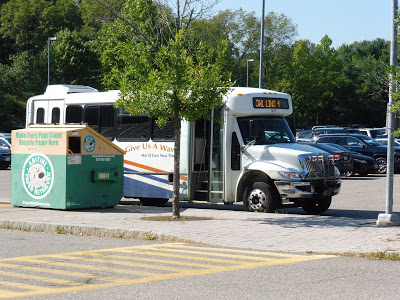 |
| Wait, that says “OWL Link 4″… |
Ah, so it turns out that the “Wareham/Middleborough/Lakeville MBTA Connector” is actually an extension of the Link 4 in Wareham. This leads to some confusion between the two, which we’ll talk about later. Also, the route was using one of those horrible “truck” minibuses that I can’t stand – the suspension is horrible, the bus is loud, and the wheelchair lift is extra-jiggly.
 |
| I can see into Lakeville! |
We made our way out of the Middleborough/Lakeville parking lot onto Commercial Drive, then we turned onto South Main Street. This took us under I-495, and outside of some suburban businesses, we turned onto East Grove Street. There was a huge variety of scenery along here, including schools, houses, and businesses.
 |
| Some gross scenery. |
 |
| A rear view shot! |
 |
| Some of that industry. |
 |
| Someone commuted here!!!!!! |
 |
| ARGH! |
 |
| ARRHGHRHGHHGRHHRHJHJGHGGHGGHGHG!!!!!!!!!!!!!!!!!! |
 |
| Cranberry bogs! |
 |
| Nope, still says “OWL LINK 4.” |
Middleborough/Lakeville
This is one of the biggest jumps I could possibly make – we’re going from the PVTA in western Mass to an MBTA station just a few towns away from Cape Cod. And just like the Cape itself, Middleborough/Lakeville is a boring place. Boom, roasted! Sorry, I just don’t like the Cape that much…
 |
| Looking down the platform. |
Yes, we’ve got a typical Old Colony station on our hands. You’ve got all the classics: a typical 90s shelter, some benches, and some wastebaskets. The platform extends beyond the shelter itself with a few more benches, but this is actually a longer shelter than usual.
 |
| Some of the parking lot, with some transit-oriented development in the background. |
Of course, this station offers a ton of parking: 769 spaces to be exact. The T got rid of its availability percentages on its new website, so unfortunately, I have no idea if this lot is big enough. Bikes get a scrawny 8 spaces, but it’s something, and we’re in a pretty suburban area. Finally, the GATRA runs two buses here, and I totally definitely did not ride one of them…
 |
| Oh darn it, there’s my reflection in the train window… |
Station: Middleborough/Lakeville
Ridership: This is a busy station for Commuter Rail standards, with 886 riders per weekday. I came here on a reverse-peak morning rush trip, so of course my train was quiet, but there was a steady stream of people getting on to go back into the city.
Pros: It’s a typical Old Colony station. That’s basically all there is to it.
Cons: Aside from the boringness and the fact that they opted to make a huge park-and-ride instead of serving the downtown, not much.
Nearby and Noteworthy: Middleborough has what appears to be a decently-interesting town center, but the station is located far from it. Instead, you can visit such amazing places as: CVS! Sterling Place Apartments! And the Massachusetts Department of Environmental Protection! Wowie!
Final Verdict: 7/10
Not much to say – it’s what you would expect from an Old Colony station. Yay!
Latest MBTA News: Service Updates
PVTA: 39 (Smith/Hampshire/Mount Holyoke)
Well, here we are. The last PVTA route. This took way longer than I thought it would, but we’ve finished the second-busiest RTA in Massachusetts. Our final route is quite possibly the most scenic one on the whole system: the 39, the one Amherst route that doesn’t serve UMass.
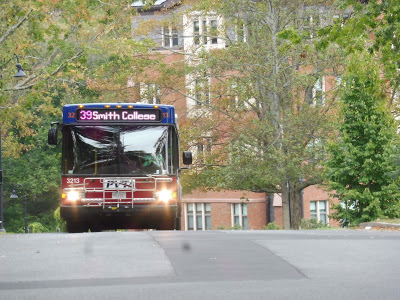 |
| The bus ascending a hill at Mount Holyoke College. |
But this is no ordinary 39 review: no, we’re going to be looking at the 39’s express service. Four trips per weekday run “express” service from Mount Holyoke College to Smith College, and it’s a completely different route from the normal “local” service, which we’ll be looking at later on. For now, let’s start at Mount Holyoke on an express trip!
 |
| Some foliage and fields. |
We headed out of Mount Holyoke and went up College Street for a bit, running through the tiny downtown of South Hadley. We turned onto Hadley Street next, and it quickly turned to houses, which quickly turned to farmland, which quickly turned to woods. We crossed over a small river, and soon after, we were seeing a mixture of houses and farmland.
 |
| This is AMAZING! |
Soon we curved north and entered Hadley, where the street became Hockanum Road. This is where the views got incredible: there was farmland on both sides, with one end running flat towards the Connecticut River and the other side rising up towards mountains. I was sitting on the mountain side, and the views were some of the best I had ever seen on a bus.
 |
| Another one! |
We came pretty close to the Connecticut River, but there was a layer of trees blocking the view. We curved away from it pretty quickly, running through woodsy hills before the street turned into Lawrence Plain Road and emptied out into flat fields. We eventually joined up with Bay Road and went over the tiny Fort River.
 |
| Those mountains still look awesome. |
Bay Road was now a mixture of houses and farmland, but once we joined up with Russell Street and the B43, we got a taste of some of the horrible suburban businesses that plague that route. It didn’t last for too long, though, as we soon went over the Connecticut River into Northampton.
 |
| Oh…well, we’ll go over the bridge once we get through all this traffic. |
We went under I-91, then it was mostly dense houses, aside from the Sheldon Field Park-and-Ride. We passed a cemetery and soon the road curved, taking us past a post office and under the Amtrak tracks. After going through lovely downtown Northampton and all of its charming and wonderful businesses, we turned onto Elm Street and travelled for just a bit more before arriving at Smith College.
 |
| The 39 with an articulated B43 bus in the background. |
Sam and I waited at Smith about 25 minutes to get the local trip back, which would take us to Hampshire College. Once the bus showed up, we went the same route as the express for a while, going back into Hadley over the bridge and merging onto Bay Road. However, whereas the express heads onto Lawrence Plain Road after the Fort River crossing, the local trips stay on Bay.
 |
| So much corn…this is like a mountainous Kansas. |
The scenery along Bay Road was awesome, too – it was more farmland and houses, with some great mountain views in the background. The bus window was open and some absolutely wonderful smells were wafting in. Manure, anyone? It was also a really quick trip, and we pulled into the Hampshire College campus in no time. We meandered through it for a bit before ending at the main building where the other Hampshire College buses loop around.
 |
| The bus at Hampshire. |
PVTA Route: 39 (Smith/Hampshire/Mount Holyoke)
Ridership: The 39’s ridership is quite low, getting only about 8 passengers per trip. I’ll bet that’s averaged out, too – there are probably certain trips that get lots of people and certain trips that are practically empty. Both of my rides were quiet, especially the express trip, which only had three other people on board.
Pros: This is a very very important route, despite the low ridership. It’s crucial for connecting up important colleges without forcing people to transfer at UMass, allowing for a direct trip from Smith to Hampshire Colleges. Oh, and the views are incredible.
Cons: I’m not completely convinced this route needs to run all the time. I mean, every half hour on weekdays is probably okay, but does it really need to run on weekends with its anemic 90-minute headways? Correct me if I’m wrong (and I don’t have access to data to back me up with this), but it seems to me that weekend service isn’t all that necessary. Something that I can complain about definitively, though, is the coordination with the 38. Going towards Mount Holyoke College, the 39 offers a perfectly-timed transfer with the 38 at Hampshire. Heading the other way, though, the 38 arrives five minutes after the 39, meaning Mount Holyoke students can’t get to Smith.
Nearby and Noteworthy: Who cares about the colleges? The ride itself is incredible!
Final Verdict: 6/10
The 39 is a very important route to the Five-College Consortium, but it could be run a lot more efficiently. The bad timing with the 38 means that it can only connect with Mount Holyoke College in one direction, and this could easily be fixed by shifting the 39 five minutes ahead. As for the weekend service, maybe the route does get well-used, but the idea of a bus that runs every 90 minutes getting well-used is hard to believe.
Latest MBTA News: Service Updates
Well, I’ve had an awesome time reviewing the PVTA. This has been a great and unique system, and I had a blast riding all of it. I’m still in the midst of the school musical and I’ve yet to have time to sit down and start Downtown Crossing, but I promise it will eventually come.
PVTA: 38 (Mount Holyoke/Hampshire/Amherst/UMass)
One of the great things about the Amherst area is the Five-College Consortium, allowing students to take classes in five great colleges, all in relatively close proximity to each other. One of the most important connectors between them is the 38, which serves four of the five! That’s awesome!
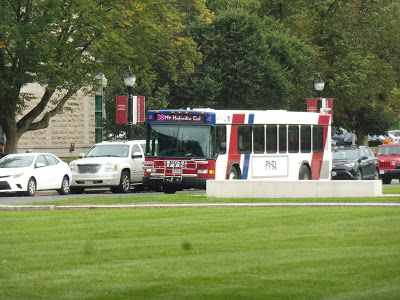 |
| The bus coming into Haigis Mall. |
We left Haigis Mall at UMass and headed down Massachusetts Ave to North Pleasant Street. This took us past some final UMass buildings, around a park, and into Amherst Center, where there were businesses everywhere. We continued south from there on South Pleasant Street, but we didn’t get too far before looping around the Amherst Town Common in order to serve Amherst College.
 |
| Looking out over the common. |
We returned to South Pleasant Street, which became mostly residential as we left Amherst Center. Eventually it became West Street, but it was still almost entirely houses, aside from a few businesses at the intersection with Pomeroy Lane. At a certain point, the trees and houses gave way to fields and farms, signifying that we were close to Hampshire College.
 |
| Here we are! |
We headed into the college, running on a windy road through the fields. We made a little deviation to serve a main building, then we continued our leisurely path through the campus. After looping around the Eric Carle Museum, we turned onto Bay Road, passed Atkins Farms, and came back onto West Street.
 |
| A few more Hampshire buildings. |
As we continued south through the Holyoke Range, the scenery could only be described as woodsy and hilly. We passed some place called The Notch and its accompanying visitor’s center, then we had a brief section in Granby, where houses started to show up again. The road was now called Amherst Road, and as we entered South Hadley, we started to see some more woods and fields.
 |
| I have no idea where I took this, but trees! |
The road curved west, then made a sharp turn south and became Woodbridge Street. There were houses for a bit before we came into downtown South Hadley, where there were some nice businesses and a common. Normally the route would turn right into Mount Holyoke College here, but there was a detour, so we headed down to Morgan Street and used that to make a small loop to the stop at Mead Hall.
 |
| The bus looking tall and mighty at Mount Holyoke. |
PVTA Route: 38 (Mount Holyoke/Hampshire/Amherst/UMass)
Ridership: It’s lower than I was expecting, but the route gets about 790 people per day. My trip had about 25 people, with a decent split between those going to Hampshire College and those going to Mount Holyoke College.
Pros: This is a crucial route for the Five College Consortium, connecting four out of the five schools. It’s fast, too, running straight as an arrow down mostly woodsy roads when it’s not deviating to serve colleges. Finally, it has a good schedule for the ridership it gets: weekday service is every half hour, Saturday service is every 40 minutes, and Sunday service is every 80 minutes.
Cons: Things get a little complex when it comes to school breaks, with different schedules pertaining to very specific, sometimes random times. For example, there’s an “End of December” schedule that operates only from December 26th-29th! Also, it really doesn’t seem necessary for the route to deviate into Amherst College, since it’s so close to the main road, but I guess it’s not that big of a deal.
Nearby and Noteworthy: UMass, Amherst College, Hampshire College, or Mount Holyoke College…take your pick!
Final Verdict: 8/10
This is a really solid route. It’s straight, it’s direct, it’s frequent when it has the most ridership, and it gets a good amount of people. Just keep in mind that on December 26th-29th, the 38 only operates five trips per day. DON’T SAY I DIDN’T WARN YA!!!
Latest MBTA News: Service Updates
PVTA: 34 (Campus Shuttle/Northbound) and 35 (Campus Shuttle/Southbound)
It’s so weird imagining a deviatory loop getting busy, and yet here we are! The 34 and 35 run a crazy figure-8 loop around the UMass campus in opposite directions, and we’re about to see how many deviations are possible within it!
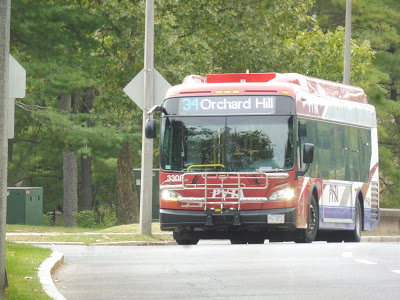 |
| The 34 coming into Southwest. |
We headed down Massachusetts Ave for a bit, passing mostly parking lots and Haigis Mall. We turned onto North Pleasant Street next, running past the three UMass stops that most other routes serve: the Studio Arts Building, the Integrative Learning Center, and the Graduate Research Center. After all that, we made our way onto Eastman Lane at a roundabout.
 |
| A pond along Eastman Lane. |
We went by some housing for a bit, then it became woodsey until the UMass Police Station. There, we turned onto East Pleasant Street, then deviated into Olympia Drive. Also, within that deviation, we had to make another deviation onto Mather Drive! This whole thing was to serve UMass Admissions, a housing development, and a fraternity.
 |
| A forested road. |
We returned to East Pleasant Street, but then turned off it pretty quickly onto Orchard Hill Drive. This was another deviation, this time to serve the Orchard Hill residential area. We passed lots of big dorm buildings as we made our way through the deviation before making our way back onto East Pleasant.
 |
| They call it Orchard HILL for a reason! |
It was all residential along here now, with normal, non-student housing. We came pretty close to Amherst Center, but we swung around onto North Pleasant Street before we could get there. This took us back up into the UMass campus, where we did that exact same section past the three main stops that we had done before.
 |
| Somewhere in the campus… |
This time, however, we made a left at the roundabout, going down Governors Drive. We passed a lot of UMass engineering buildings, as well as the UMass Transit bus garage. Soon after that, we had to do a deviation to serve a parking lot – Lot 12, to be exact. Yay.
 |
| Hey, a 35 is making the deviation too! |
We came back to the main road, which was now called Commonwealth Ave. It took us past the Mullins Center and the huge athletic complex around it, as well as the dorms for the UMass Honors College. We turned onto Mass Ave again briefly, then headed down University Drive. Here, we made a loop via Stadium Drive, which served more athletic facilities, some parking lots, and the UMass Child Care Center. Finally, we went back up to Mass Ave and arrived at the stop where we had started, Southwest.
 |
| A 35 at the Integrative Learning Center. |
PVTA Routes: 34 (Campus Shuttle/Northbound) and 35 (Campus Shuttle/Southbound)
Ridership: These routes both get pretty good ridership – 844 people per day for the 34 and 1,120 people per day for the 35. On a trip-by-trip basis, though, certain ones can be empty, while others can be packed. It all depends on the time of day.
Pros: Both routes run every 15 minutes on weekdays, a good frequency for a campus shuttle. Weekend service is much less frequent, with no 34 service and a 35 every 45 minutes, but I doubt it needs to run more often than that. The routes are very useful for connecting further-out parts of campus, such as Southwest and Orchard Hill, and since they go in both directions, you shouldn’t have to suffer through too many deviations to get to where you want to go.
Cons: That being said, the routes are still very deviatory. Most of the time the deviations do get people, but they can feel a little annoying and unnecessary sometimes. Also, the morning section of the 35’s schedule has a really bad typo where some trips lose time at certain places…it doesn’t make any sense.
 |
| That third timepoint is looking a little strange… |
Nearby and Noteworthy: I mean, they’re literally entirely within the UMass campus, so that’s all that’s nearby and noteworthy.
Final Verdict: 7/10
I can’t bring myself to give a route with so many deviations higher than a 7, but the 34 and 35 still do their job great. They run frequently, and they can reliably get people to basically wherever on campus they want to go. What more do you need? The route can even travel back in time, if the schedule is to be believed!
Latest MBTA News: Service Updates
PVTA: OWL (Westfield State University Shuttle)
You thought Harvard’s shuttle system was confusing? Well, yeah, you’re right, but here’s a college shuttle that may be able to give Harvard a run for its money. I’m talking about the OWL, the PVTA’s shuttle within Westfield State University!
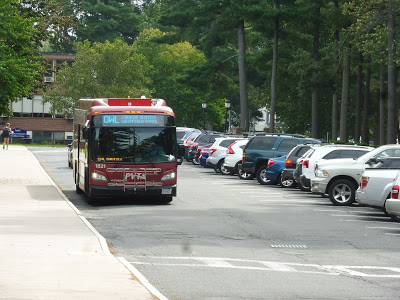 |
| Why’s it stopping all the way over there?? |
“Where are you going?” the driver asked accusingly as Sam and I got on. Great, one of these drivers. I said, “WellIwriteablogaboutpublic-transportationandI’mtryingtofinishthewholePVTAandthisisoneofthelast-routesIhavetodosocouldwejustridearoundthanks.” “Uh, sure, you can ride around,” the driver said. Nailed it.
 |
| Coming out of Scanlon Hall. |
We headed down Western Ave, passing houses and a few WSU buildings, then we headed down into the university’s South Lot. After looping around the very busy parking lot, we returned to Western Ave and went the other way. We went by Scanlon Hall without stopping and eventually made our way into the university’s Administration Building. Since the actual stop was in an impossible-to-get-to part of the parking lot, we just sorta stopped on one of its main roads, briefly blocking traffic. Finally, we came back to Western Ave one more time, passing a stop for the Athletic Complex, and returned to Scanlon Hall.
 |
| That was quick! |
PVTA Route: OWL (Westfield State University Shuttle)
Ridership: No stats on this one, either, but my trip was very quiet, with only about five people the whole time. Maybe the trips when classes end are busier?
Pros: I like that the route times with class start and end times. That’s very clever. Oh, and it’s free.
Cons: The route has very frequent service, with a bus every 13 minutes. Oh wait, this trip has a 14-minute gap. Hang on, here’s one with an 8-minute gap! Why is there a 40-minute gap in the middle of the day? Wait, wait, there are certain trips that don’t serve South Lot? And here’s one that doesn’t serve the Administration Building! WHY IS THIS SO RANDOM????
Nearby and Noteworthy: Westfield State University. That’s it.
Final Verdict: 2/10
I swear, this bus just does whatever it wants, whenever it wants. It only has four stops, how the heck is it this confusing? Not to mention, each stop has a certain amount of layover time, and that always seems to be random, too! Also, why is the PVTA stuck with this thing when WSU has its own bus that literally does the same route? Sure, it only goes from Scanlon Hall to South Lot and it runs every two hours, but it could easily just replace the OWL! This is ridiculous.
Latest MBTA News: Service Updates
PVTA: R10S (Westfield Center/Westfield State University)
When I reviewed the R10 over the summer, it was on its school vacation routing, where it runs all the way to Westfield State University. During the school year, however, the R10 terminates at Westfield Center and they run a shuttle route, the R10S, from there to the university. I wonder what it’s like!
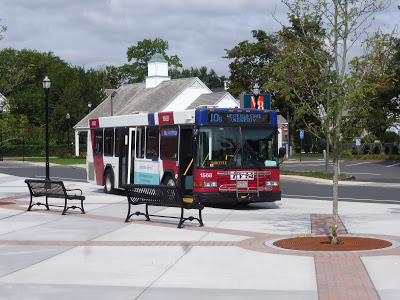 |
| Okay, that destination sign is distinctly blue! |
The first thing to mention about the route is that it’s free! That definitely gives it some points from the cheap side of me! So, we left the Olver Transit Pavilion and headed into the Park Square rotary. Surely we would get to go directly to the univer- oh, we’re deviating into Stop & Shop? We’re really gonna do this? Alrighty, then…
 |
| Hi, parking lot. |
After that whole kerfuffle, we returned to Park Square and actually made it onto Court Street, heading out toward the university. It was mostly houses, with a few breaks for Westfield City Hall, Baystate Noble Hospital, a cemetery, and an elementary school. The street eventually became Western Ave, and after a bunch more houses, we pulled into Scanlon Hall of Westfield State University. That was a quick one!
 |
| The bus’s rear end. |
PVTA Route: R10S (Westfield Center/Westfield State University)
Ridership: I haven’t got any online ridership statistics for this one, but from my experience, the route gets very low ridership. Maybe it’s different at certain times of the day, but I never saw more than three people on this thing.
Pros: It’s free! Also, it provides half hourly service from Westfield State to downtown Westfield. And…Stop & Shop. Sigh…
Cons: Does the route really need to serve Stop & Shop? I mean, we’re talking about college students here – I think they should be able to perform the 5-minute walk from Olver to the supermarket. Plus, if that deviation was eliminated, the route could easily run every 20 minutes instead of every 30, which is a much better frequency for a college shuttle (even though this seems to get low ridership anyway). Also, the time required for the Stop & Shop deviation means that the R10S can’t coordinate with the inbound R10. Oh, that’s just great, isn’t it?
Nearby and Noteworthy: This route exists solely to get people to Westfield State, so I guess that’s about it.
Final Verdict: 4/10
This route has a lot of potential to be a really convenient free shuttle for college students. However, it doesn’t run all that frequently, it doesn’t connect with the inbound R10, and it has to make that stupid Stop & Shop deviation. I have a solution, though, and it assumes that the Stop & Shop deviation is required for some political reason – you see, it turns out that the route really doesn’t have a half hour cycle time, it’s just some good ol’ fashioned PVTA padding. The route can complete its trip in about 16 minutes, 18 if you include Stop & Shop, meaning that it could still be effectively run every 20 minutes. That would allow for coordination with the R10 in both directions, too! Here, I made up a schedule:
Okay, the header got a bit messed up for some reason, but you get the idea. I figured that the trips that don’t connect with the R10 could still serve Stop & Shop, since the ones that do connect need to be right on time. That being said, this whole 20-minute thing would work way better without the Stop & Shop deviation at all, and if it could be eliminated, that would make this schedule optimal.
UPDATE 9/11/2020: I guess this route has been eliminated?? I’m not sure if it’s because of COVID or if it’s permanent, but the PVTA specifically said “eliminated” and took it off the website. Hmm…
Latest MBTA News: Service Updates
